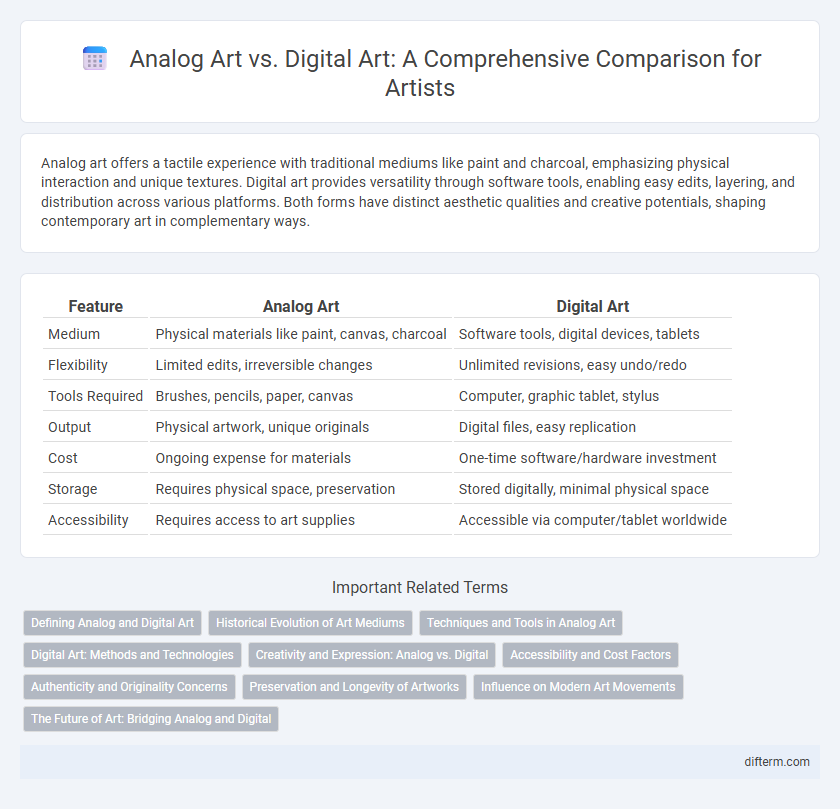Analog art offers a tactile experience with traditional mediums like paint and charcoal, emphasizing physical interaction and unique textures. Digital art provides versatility through software tools, enabling easy edits, layering, and distribution across various platforms. Both forms have distinct aesthetic qualities and creative potentials, shaping contemporary art in complementary ways.
Table of Comparison
| Feature | Analog Art | Digital Art |
|---|---|---|
| Medium | Physical materials like paint, canvas, charcoal | Software tools, digital devices, tablets |
| Flexibility | Limited edits, irreversible changes | Unlimited revisions, easy undo/redo |
| Tools Required | Brushes, pencils, paper, canvas | Computer, graphic tablet, stylus |
| Output | Physical artwork, unique originals | Digital files, easy replication |
| Cost | Ongoing expense for materials | One-time software/hardware investment |
| Storage | Requires physical space, preservation | Stored digitally, minimal physical space |
| Accessibility | Requires access to art supplies | Accessible via computer/tablet worldwide |
Defining Analog and Digital Art
Analog art refers to traditional artistic methods involving physical media such as paint, charcoal, and clay, emphasizing tactile engagement and material texture. Digital art utilizes computer software and digital tools to create images, animations, and interactive works, offering flexibility in editing and reproducing art. Both forms represent distinct creative processes, with analog rooted in manual craftsmanship and digital grounded in technology-driven expression.
Historical Evolution of Art Mediums
Analog art, rooted in traditional techniques such as painting, drawing, and sculpture, has shaped artistic expression for millennia through mediums like oil paint, charcoal, and clay. The rise of digital art emerged in the late 20th century, revolutionizing creativity with computer software, graphic tablets, and virtual tools that enable unprecedented manipulation and reproducibility. The historical evolution of art mediums reflects a shift from tactile, manual craftsmanship to technologically driven processes, expanding artistic possibilities and accessibility globally.
Techniques and Tools in Analog Art
Analog art techniques involve traditional tools such as brushes, pencils, charcoal, and oil paints applied on canvases or paper, emphasizing tactile engagement and material texture. Artists utilize methods like layering, blending, and cross-hatching to achieve depth and detail, often relying on manual precision and physical manipulation. The tangible nature of analog tools allows for spontaneous imperfections and unique surface qualities, distinguishing each piece with a singular artistic signature.
Digital Art: Methods and Technologies
Digital art utilizes software tools such as Adobe Photoshop, Corel Painter, and Procreate, enabling artists to create intricate designs with layers, brushes, and effects not achievable in traditional media. Techniques like digital painting, 3D modeling, and vector graphics leverage technologies such as tablets, styluses, and graphic processing units (GPUs) to enhance precision and efficiency. Advances in artificial intelligence and virtual reality further expand digital art's creative possibilities by automating tasks and immersing artists in interactive environments.
Creativity and Expression: Analog vs. Digital
Analog art channels creativity through tactile engagement with physical materials like paint and clay, fostering a direct and spontaneous form of expression that emphasizes the artist's manual skill. Digital art expands creative possibilities by integrating software tools and digital effects, enabling intricate modifications and experimental techniques that traditional media cannot easily achieve. Both analog and digital mediums offer unique avenues for artistic expression, with analog emphasizing texture and immediacy, while digital prioritizes versatility and innovation.
Accessibility and Cost Factors
Analog art requires physical materials like paints, canvases, and brushes, often resulting in higher upfront and ongoing costs, while digital art primarily needs a tablet and software, offering more cost-effective options for beginners. Accessibility to analog art can be limited by the availability of specific materials and workspace, whereas digital art benefits from portability and the convenience of numerous online tutorials and communities. The growing affordability of digital devices further democratizes artistic creation, making digital art more accessible to a wider audience.
Authenticity and Originality Concerns
Analog art maintains authenticity through direct physical interaction with materials, enabling unique textures and imperfections that underscore originality. Digital art challenges traditional notions by allowing infinite replication, yet originality persists in creative concepts, unique digital techniques, and data signatures like blockchain. The debate revolves around valuing tactile uniqueness versus the innovative potential of digital creation tools.
Preservation and Longevity of Artworks
Analog art, created with traditional materials like paint and canvas, often faces challenges related to deterioration, such as fading, cracking, and physical damage over time. Digital art benefits from easier preservation through high-quality backups and digital formats that do not degrade, allowing indefinite longevity without loss of detail. Museums and collectors increasingly rely on digital archiving and restoration techniques to ensure the enduring accessibility and integrity of artistic works.
Influence on Modern Art Movements
Analog art, characterized by traditional techniques such as painting and sculpture, has significantly shaped modern art movements like Abstract Expressionism and Impressionism by emphasizing tactile interaction and materiality. Digital art introduces new paradigms through technology, fostering movements such as Glitch Art and Digital Surrealism that explore virtual realities and data manipulation. The synthesis of analog and digital methods continues to expand artistic expression and challenge contemporary aesthetic boundaries.
The Future of Art: Bridging Analog and Digital
The future of art lies in the seamless integration of analog and digital techniques, where traditional mediums like painting and drawing coexist with digital tools such as graphic tablets and software. This hybrid approach expands creative possibilities, allowing artists to blend tactile textures with digital precision, resulting in innovative and multifaceted artworks. Emerging technologies like augmented reality and blockchain further enhance this fusion, enabling new forms of art production, distribution, and ownership.
Analog art vs digital art Infographic

 difterm.com
difterm.com